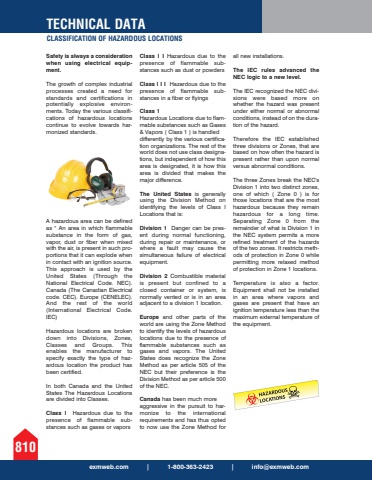Page 842 - Demo
P. 842
TECHNICAL DATACLASSIFICATION OF HAZARDOUS LOCATIONS810exmweb.com | 1-800-363-2423 | [email protected] is always a consideration when using electrical equipment. The growth of complex industrial processes created a need for standards and certifications in potentially explosive environments. Today the various classifications of hazardous locations continue to evolve towards harmonized standards. A hazardous area can be defined as \substance in the form of gas, vapor, dust or fiber when mixed with the air, is present in such proportions that it can explode when in contact with an ignition source. This approach is used by the United States (Through the National Electrical Code. NEC). Canada (The Canadian Electrical code. CEC). Europe (CENELEC). And the rest of the world (International Electrical Code. IEC) Hazardous locations are broken down into Divisions, Zones, Classes and Groups. This enables the manufacturer to specify exactly the type of hazardous location the product has been certified. In both Canada and the United States The Hazardous Locations are divided into Classes. Class I Hazardous due to the presence of flammable substances such as gases or vapors Class I I Hazardous due to the presence of flammable substances such as dust or powders Class I I I Hazardous due to the presence of flammable substances in a fiber or flyings Class 1Hazardous Locations due to flammable substances such as Gases & Vapors ( Class 1 ) is handled differently by the various certification organizations. The rest of the world does not use class designations, but independent of how this area is designated, it is how this area is divided that makes the major difference. The United States is generally using the Division Method on identifying the levels of Class I Locations that is: Division 1 Danger can be present during normal functioning, during repair or maintenance, or where a fault may cause the simultaneous failure of electrical equipment. Division 2 Combustible material is present but confined to a closed container or system, is normally vented or is in an area adjacent to a division 1 location. Europe and other parts of the world are using the Zone Method to identify the levels of hazardous locations due to the presence of flammable substances such as gases and vapors. The United States does recognize the Zone Method as per article 505 of the NEC but their preference is the Division Method as per article 500 of the NEC. Canada has been much more aggressive in the pursuit to harmonize to the international requirements and has thus opted to now use the Zone Method for all new installations. The IEC rules advanced the NEC logic to a new level. The IEC recognized the NEC divisions were based more on whether the hazard was present under either normal or abnormal conditions, instead of on the duration of the hazard. Therefore the IEC established three divisions or Zones, that are based on how often the hazard is present rather than upon normal versus abnormal conditions. The three Zones break the NEC's Division 1 into two distinct zones, one of which ( Zone 0 ) is for those locations that are the most hazardous because they remain hazardous for a long time. Separating Zone 0 from the remainder of what is Division 1 in the NEC system permits a more refined treatment of the hazards of the two zones. It restricts methods of protection in Zone 0 while permitting more relaxed method of protection in Zone 1 locations. Temperature is also a factor. Equipment shall not be installed in an area where vapors and gases are present that have an ignition temperature less than the maximum external temperature of the equipment.


